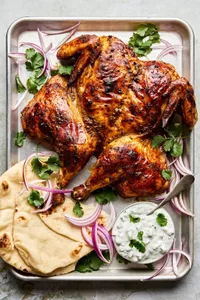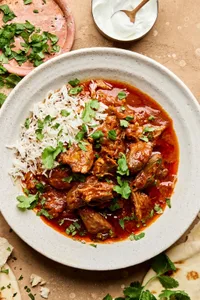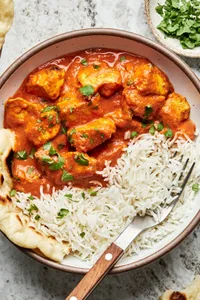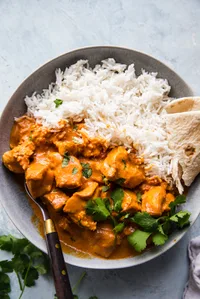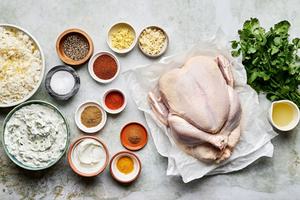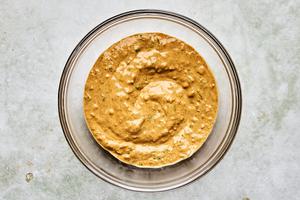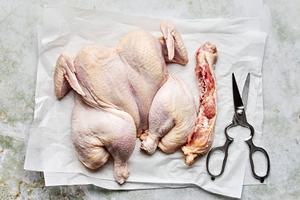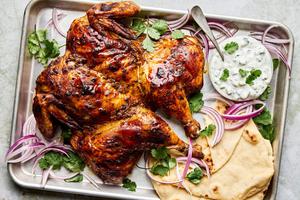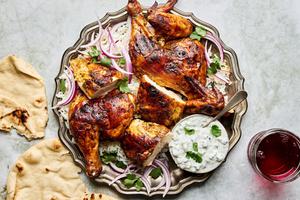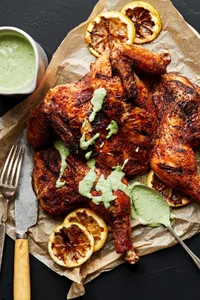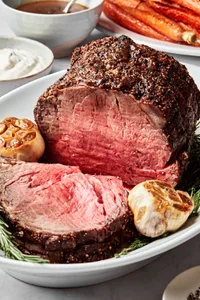Why People Love Our Recipe
Whether you need a show stopper for company, or just a weekly rotation refresh, give Tandoori Chicken a try! Since we first shared this recipe, our readers have shared their reactions — if you don’t believe us that this recipe rocks, just take it from them:
- “The Tandoori sauce is the bomb! Served with the raita, basmati rice and naan. Thank you! I didn't know I could make Indian food as good as my favorite takeout.”
- “Best tandoori chicken recipe I have ever tried. The flavours are incredible and the chicken is so tender and juicy. I will be making this for my family many years to come!”
- “This is amazing! It was out of my comfort zone to prepare a chicken in this manner, but I’m so glad I gave it a try. The marinade is delicious. Definitely a hit and will be making again!”
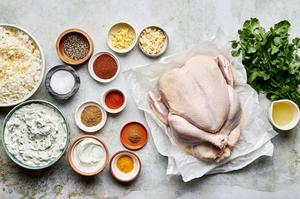
What is Tandoori Chicken?
A tandoor is a coal-fired clay oven that is commonly used for cooking bread — like Indian naan — and meat in Middle Eastern and South Asian countries. So, tandoori chicken means chicken that is cooked in a tandoor oven. If you don’t have a tandoor oven lying around at home (and we’re betting you don’t) you can still make really delicious tandoori-style chicken, because a regular oven works just fine. Much of what we all love about the tandoori chicken that we order in restaurants is all about the uniquely spiced yogurt sauce and marinade. Tender and juicy, our roasted tandoori chicken recipe approximates the smoky heat of a traditional tandoor oven by slowly roasting a whole spatchcocked chicken that’s been slathered in Indian spices and cooling, creamy yogurt.
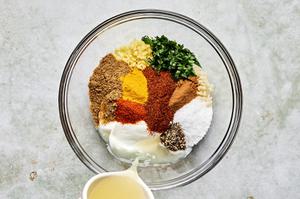
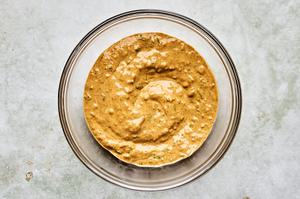
Good To Know: Key Ingredient Notes
- Yogurt marinade: Yogurt and lemon juice make for a pretty magical marinade, and by magical we mean scientifically interesting! Yogurt has lactic acid, which works beautifully to gently tenderize meat. The keyword here is gentle! It will yield unbelievably tender, moist chicken. The lemon juice, meanwhile, has citric acid which breaks down the meat more quickly. The two together balance each other out and work to make the chicken really tender and flavorful, pretty quickly.
- Spices: Fresh garlic and ginger, plus ground turmeric, chili powder, cayenne powder, cinnamon, cumin.
- Chicken: To ensure super even cooking, and lots of roasty, crispy flavorful bits of skin you’ll want to spatchcock the chicken. It’s our favorite trick for cooking a whole chicken really evenly — in grilling season, try our Spatchcocked Grilled Chicken, too! It can be a little intimidating the first time you do it, but it’s not hard. Good-quality kitchen shears are helpful. If you really don’t want to do it yourself, oftentimes friendly butchers will do it for you — doesn’t hurt to ask!


How To Make Tandoori Chicken
- Whip up the tandoori-spiced marinade: yogurt, lemon juice, ginger, garlic, turmeric, chili powder, cayenne powder, cinnamon, cumin, cilantro, salt and pepper
- Spatchcock your chicken. (click here to learn how to spatchcock a chicken).
- Using your hands or a pastry brush, coat the whole chicken entirely in the tandoori-seasoned yogurt mixture.
- Lay the whole chicken, with the meaty side up, on a baking sheet—ideally, one that is lined with a cooling rack. This will help the chicken skin to develop a beautiful crispyness that mimics the kind of crispy skin that chicken cooked in a tandoor oven would develop.
- Roast! For a little over an hour. Your spatchcocked, roasted tandoori chicken is done when an instant-read thermometer inserted into the thickest part of the thigh (but not touching bone) reads 165° F.
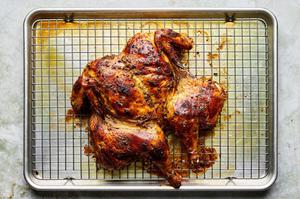
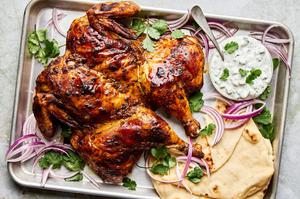
What To Serve With Tandoori Chicken
Rusty hued and bursting with the scent of the best Indian restaurant you could dream up, we love to serve this whole roasted tandoori chicken as a really dramatic centerpiece for a dinner party. Simple, with bold flavors and a gorgeous, roasty crispy crust, all it needs are some delicate, perfect sides. Serve it with:
- Raita. A simple, herb-flecked condiment made of yogurt and cucumber, homemade Raita served on the side takes this chicken dinner over the top. If you don’t want to make it yourself, you can often find it in specialty stores, too. Look in the refrigerated section, near where you’d find the hummus.
- Naan. It’s pretty easy to buy good naan, many stores carry it. You could even order it from your favorite restaurant early in the day, and warm it in the oven right before dinner.
- Rice. You could serve plain basmati rice, or make it fancy! Lemon rice, Coconut Rice or even Cilantro-Lime Rice would all make really nice sides.
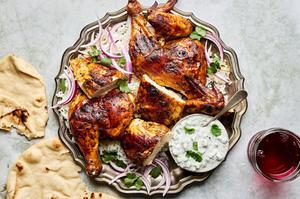
Other Indian-Inspired Recipes To Try
So, Are You Convinced?
For more recipe inspiration, follow us on Facebook, Instagram, TikTok and Pinterest or order our cookbook. We love when you share your meals. Tag us on Instagram using #themodernproper, and we’d love to hear what you think of this recipe in the comments below. Happy cooking!
